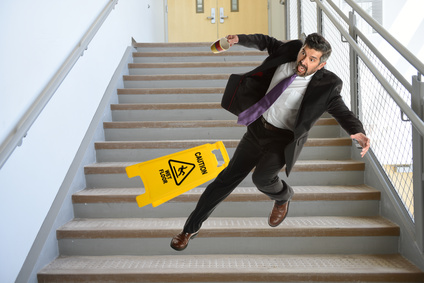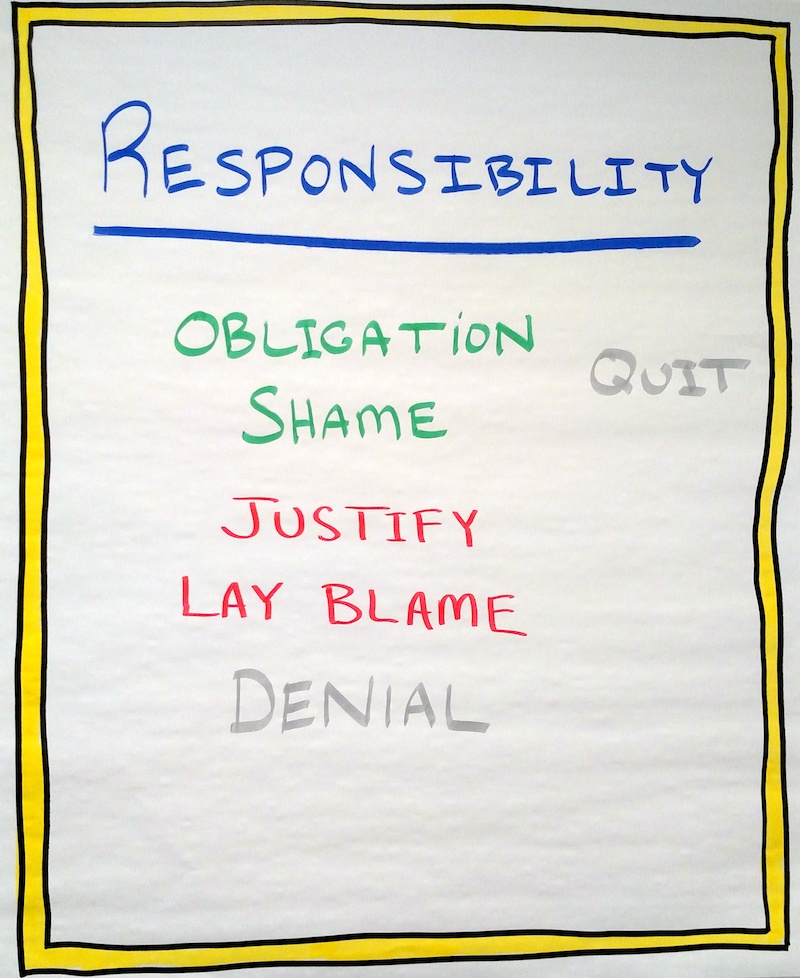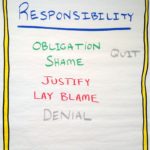The Responsibility Process™ is a practice (some may argue it’s more or less than a practice) that helps us move towards more self-mastery. Being able to facilitate ourselves is all about emotional intelligence – our ability to recognize and react appropriately in the moment to our emotions.
The Responsibility Process has been around for quite some time, so I’m still surprised that so few people are aware of it. The Responsibility Process is a structure to become aware of the states we all move through or get stuck in, as we aim to move to a mindset of responsibility. The Process was created by Christopher Avery who spent years researching the idea (you can read more at Christopher Avery’s website or just search Google!).
A Summary
Through years of research, Avery determined that responsibility is not a character trait that some people have and others don’t.

Responsibility is something that we can see and learn — it is a mental state.
That alone is an interesting concept, since we often say ‘that person is irresponsible.’ Maybe we mean, ‘based on my perception, that person is acting irresponsibly.’?
There are a number of mental states that we go through when something interrupts our movement towards a goal. Ideally, we move through them to get to responsibility. These are emotions or feelings that, if we can work from responsibility and be aware and engaged with this process, we are better able to manage.
I’m going to explain the states from bottom to top (referencing the poster), since these are the states we typically move through sequentially. When we are able to ‘figure out’ one state, we are effectively moving on to the next one.
When we fall out of the mental state of responsibility, we end up searching for answers and end up in these other states.
- Denial

The Responsibility Process Poster — you can download official posters at Christopher Avery’s website above. – We are not aware of the issue. Some say this is ignoring the problem, but it’s really not even knowing there is an issue to contend with.
- Lay Blame – When we are here we believe that external forces are at fault. This is all about giving away our power because we are convinced that someone else is in control here. If we realize we have no power to effect any change here, we can move to the next state.
- Justify – Justify is about rationalizing why the situation makes sense. You might hear “it has always been this way” as one type of justification. Something ‘out there’ must change for the issue to go away. Moving to this state from blaming someone for a problem might be a solid step forward, but realize that if you are now justifying why that person caused a problem (e.g. they have never been trained) you still are not at a place of ownership. In this justify, you are still in a powerless state, believing again that external forces must change.
- Shame – Shame is self-blame. As we move past believing that external forces are at fault, we turn the fault inward on ourselves. We might say “I can’t believe I did that again” or “I’m such an idiot of falling for that one.”
- Obligation – This state is about believing you are doing what you must. We make commitments because we have to do ‘this!’ But if we are stuck doing things where we feel we do not have any choice, we don’t have ownership.
- Quit – this is simply a way to attempt to avoid the issue. You might be trying to avoid the drama or trauma of the situation or you might simply be exhausted by obligation or shame. In any case, we check out. This can feel a lot like Stonewalling.
- Responsibility – Avery says this means “I have the power and the ability to find and resolve the real problem.” When I have the mindset that this is mine to solve or to act on, I can access new options to make changes — often that simply did not exist in the other states of the process.
An example: I was in a situation a while back where I volunteered to help someone with a class. While I was only a volunteer, it was an important part of the class. I got a call that a client needed me at the same time. I felt obligated both to take the work and to help with the class. I was mad at myself for getting into the situation and quite upset that I was going to let this person down. The person I was going to volunteer for said they understood, but was also clearly not happy about the situation (which I understood!). I could justify why I needed to take the client work, since it paid and volunteer position did not — or say “I need to be “responsible” for my family!” So many options! When I actually shifted to responsibility, I realized that I did need to take the client work, but also needed to go out of my way to find someone who could step in to replace me. Finding a replacement truly seemed impossible when I was in the coping states of blame, justify, shame, and obligation. I did find someone to replace me and they were very excited to do it. In the end, shifting allowed me to see more options and press through them even though they were challenging.

We may only be in a state for a second or even less. You might find that as you start to blame you switch mid-sentence to justify. So they are not all necessarily resting places where we stay for a long period of time. Imagine yourself riding a bike towards responsibility and notice off to the side that blame and justify are there, sitting on the curb. They ask you to stop and chat for a while, but you simply smile and wave to them and continue on your journey to responsibility.
Doing the self-work to move to a responsibility mindset is a critical part of growing as a human and is a requirement for good leadership (regardless of your role or title).
Context and Safety
While I’ve used The Responsibility Process for myself and within organizations, as I started to work on this article, I realized I tended to use it with certain assumptions in place. I look at it and talk about it with a focus on personal responsibility (I’ll talk about teams in a future article). I also tend to use it in situations where people have options to shift their mindset, not extremely oppressive situations.
I have tried not to use The Responsibility Process in contexts where safety was clearly missing or where there was major privilege, rank, and/or power at play. To shift, you need to be at choice to move along the states of the process to get to responsibility. You need to see options. Some may argue that we always have a choice, but if you are in a place of rank or privilege making that argument, your judgement may be impaired. Beyond business situations (where this can occur as well) consider this idea and how it might apply to many of the situations out in the world today.
An example: If you are in a situation with a terrible boss who yells at you and belittles you, with all power aligned to that person, you can’t find another position, and need to support yourself or family — the idea of simply choosing to move out of justify or blame would likely strike you as absurd. That said, lets say you were able to move beyond blame and justify. You decide you are done with shame (I’m terrible and that’s why I get yelled at) and have moved past obligation (to do the job and help all the organizations end customers). The responsibility mindset allows you to theoretically move past those — and you continue to look for another job, but also stay in the hostile environment because you are responsible for your family. Saying this is no easy task would be an understatement!
If you don’t have safety, getting to responsibility is a lot more challenging. If people are not safe, they will have less options and less ability to change mindsets. Increasing safety may be something to focus on if you want people to exercise more responsibility. That may increase peoples options to choose from.
Being Responsible
Write the steps down and paste it on your wall or your laptop. When you run into a situation ask yourself where you are. Assess what it means for you to be in each step and what it would be like to move to the next one in the process. Focus on yourself and your mindset. Work on being in a responsibility mindset and see what it does for you! Love to hear how it turns out for you!











Very nice article, Jake. I feel as though some days I am on all of these at the same time! I really like identifying where you are which seems to be able to release you and allow you to move to responsibility. I will definitely put this into my toolkit.
Rosalie, thanks! Yes, i feel the same sometimes… like I’m bouncing around a number of them. That awareness often means I have not fully moved past that step, but I can at least see I’m stuck or oscillating there!
Hi Jake, really nice blog!
Me and my friend Saloua recently started a blog about agile, http://www.agileadventures.net
We work at a large organization that recently transformed all departments (yes all, not only IT) into agile. Major change and we love the journey!
Please feel free to check out our blog and let us know what you think!
Marijke, thanks. Glad you enjoyed it. Your blog looks very interesting!
Thanks for including the part about context because power down situations do limit choices.
Joann, absolutely. So often these types of ideas are laid out from some land of magical privilege or rank — in reality it is much more challenging. When I was working on this I was actually thinking of a number of situations related to the rank and power based on our conversations!
Jake, thank you for sharing The Responsibility Process® with your audience. Rosalee, I’ve been practicing Responsibility for 24 years and I still experience all the mental states. Why? Because I am human and when we have any kind of anxiety about anything, our minds go straight to Lay Blame. The practice, as Jake indicated, is to develop your awareness of these mental states and how to actually face the problem from the only mental state where you can solve it — Responsibility.
I’m working on a book about The Responsibility Process. We will also soon be re-opening registration for an e-learning opportunity called The Leadership Gift Program. Find out about both at christopheravery.com
Christopher, absolutely! Thanks for pointing out the book you are working on!
Giving an overview of this process during system demos today. So glad I found your blog–thanks yet again! 🙂